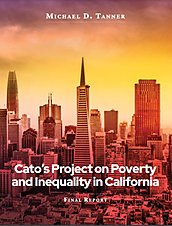Criminal justice reform is traditionally thought of more as a question of social justice—particularly at times of reckoning with racism and other inequities in the system—rather than as an anti-poverty measure. Yet a closer look shows it to be not only a consequential step toward reducing poverty but also an essential one.
As President Barack Obama’s Council of Economic Advisers pointed out in 2016:
The costs of criminal justice policies are not limited to direct government expenditures. Individuals who obtain a criminal record or serve a prison sentence often face difficult circumstances when they return to society. Having a criminal record or a history of incarceration is a barrier to success in the labor market, and limited employment or depressed wages can stifle an individual’s ability to become self-sufficient. Beyond earnings, criminal sanctions can have negative consequences for individual health, debt, transportation, housing, and food security. Further, criminal sanctions create financial and emotional stresses that destabilize marriages and have adverse consequences for children.1
Politicians love to portray themselves as “tough on crime.” But there are real consequences to heavy sentencing in terms of poverty. A study by scholars at Villanova University concluded that mass incarceration has increased the U.S. poverty rate by an estimated 20 percent. Another study found that a family’s probability of being poor is 40 percent greater if the father is incarcerated.2 Since an estimated 1.5 million children had a parent in state or federal prison as of 2016, this is an enormous problem.3 Minority children are particularly at risk. Rates of parental incarceration are two to seven times higher for African American and Hispanic children than white children. An African American child whose father does not have a high school diploma faces roughly 50/50 odds that the father will be in prison by the child’s 14th birthday.4 In addition, children of incarcerated parents are at high risk for several adverse life outcomes, including anti-social and violent behavior, mental health problems, dropping out of school, and unemployment. Harvard political scientist Robert Putnam points out that there is a “spillover effect” in areas of high incarceration, affecting even children whose parents are not incarcerated.5
Estimates suggest that if a father goes to a detention facility, the likelihood increases by 38 percent that his family will fall into poverty while he is incarcerated.6 Also, incarceration permanently affects wages. Someone who has been incarcerated can expect to earn roughly 40 percent less than someone who has avoided detention. And the effects are long-lasting. A Pew Charitable Trusts survey found that inmates released in 1986 were still in the bottom 20 percent of incomes in 2006, 20 years after completing their sentences.7
Of course, that assumes that people who were previously incarcerated can find jobs at all. Recent job application experiments find that applicants with criminal records were 50 percent less likely to receive an interview request or job offer relative to otherwise identical applicants with no criminal record. Those disparities were even more significant for African American applicants.8 A study by the National Institute of Corrections found that being arrested at any point in a person’s life was a bigger barrier to finding a job than any other employment-related stigma, including long-term unemployment, being on welfare, or having a GED instead of a high school diploma.9 Another study of recently released prisoners in New York City found that only 9 percent had jobs paying more than minimum wage and that more than half were unemployed.10
Among those with a criminal record, the combination of greater difficulty in finding a job and lower wages not only consigns them to poverty but also makes it much harder for them to provide for their families, either directly or through paying child support. That is one reason why states report that as many as 40 percent of “hard to collect” child-support cases involve a parent with a criminal record.11 This often creates a vicious cycle because failure to pay child support can result in arrest and imprisonment, making future payment even more difficult.12
Of course, incarceration is not the only reason for low wages and increased unemployment among those with a criminal record. The people most likely to go to prison are disproportionately likely to experience other markers of socioeconomic disadvantage, including low educational attainment, weak attachment to the workforce, and substance abuse or mental health problems. Approximately 65 percent of respondents to a 2003 nationwide survey of incarcerated people had not completed high school, and 14 percent had less than an eighth-grade education.13 Many were unemployed before prison, or at least not employed in traditional jobs, and pre-incarceration incomes for this group were already far below their nonincarcerated peers.14 After all, educated, financially stable individuals with few social problems are less likely to commit crimes.15
A Good Start, but Much More to Do
In recent years, California has developed a reputation as a leader on criminal justice reform. The state has made progress, significantly reducing incarceration rates even before COVID-19 forced the widespread early release of nonviolent offenders.
This is a significant shift from the state’s scandalous past. By 2006, California had more than 253,000 inmates in its adult correction facilities, including roughly 173,000 in prisons—more than double the system’s capacity.16 The inhumane conditions resulting from such overcrowding led the courts to order a reduction in the state’s prison population to no more than 137.5 percent of capacity, a decision that the Supreme Court upheld in 2011.17 In response, California passed the 2011 California Public Safety Realignment Act (Assembly Bill 109), which transferred many nonviolent and low-level offenders from state prisons to county jails.
This shifted inmates in the prison system, but there was only a modest decrease in the overall population. A much bigger change occurred in 2014 with the passage of Proposition 47, which reduced many petty offenses from felonies to misdemeanors. The legalization of marijuana in 2016 also led to reductions in incarceration.
As a result, the state’s prison and jail populations have declined by 31.5 percent since 2010 to 182,738 by 2020 (see Figure 1).
The reduction in incarceration does not appear to have led to any increase in crime rates (see Figure 2). Indeed, California’s overall crime rate is low. There was an uptick in murder rates in 2020 and 2021, but that was common in metropolitan areas across the country. Nor, contrary to some criticism, has it been a driving force behind the state’s growing problem with homelessness (see Figure 3).
COVID-19 has forced further reduction in the state’s incarcerated population. Prisons, with their densely packed populations, are natural breeding grounds for the virus. For instance, as of October 2020, three-quarters of San Quentin’s 2,900 inmates had tested positive for COVID-19, and 28 inmates had died from it. By August 2021, almost 400 prison staff also had contracted the virus, and at least one had died from it.18 Other state prisons and local jails have seen similarly high infection rates. As a result, the courts have ordered substantial reductions in prison populations. Gov. Gavin Newsom gave COVID-19 as one major reason to close two state prisons over the next three years.19 Overall, the state’s prison population has declined by 18 percent between February and July 2020. Even larger decreases occurred in some county jails.20
As a result of both COVID-19 mitigation efforts and earlier ongoing reforms, California’s prison population is now nearly as low as it was in 1993 (see Figure 4).
However, the system continues to burden communities of color and people with low incomes. About 115,000 Californians remain behind bars, many for nonviolent offenses. On a per capita basis, California’s incarceration rate ranks 32nd, higher than other large, urban states such as Illinois, New Jersey, or Massachusetts, although it’s notably lower than the median, reflecting success in some of the state’s reforms.
Achieving criminal justice reform has, of course, been complicated by the increase in shootings and other violent crime in some California cities. Many cities, including Los Angeles, Oakland, and San Diego, have seen spikes in violent crimes, especially shootings and homicides. Statewide, the murder rate in 2020 was 5.5 homicides per 100,000 population, compared to 4.2 per 100,000 in 2019. In absolute terms, this amounted to a year-on-year increase of 523 homicides.21 On the other hand, property crimes decreased from 2019 to 2020, continuing a decades-long trend that started in about 1990.
Previous criminal justice reforms, as well as the policies of reformist district attorneys, are often blamed for both real and perceived increases in crimes. Such blame is misplaced. For instance, there appears to be no correlation between changes in crime rates and the policies followed by local district attorneys. San Francisco District Attorney Chesa Boudin has pursued some of the most progressive reform efforts, yet assaults in the city are down from 2019 to 2020. Homicides have increased, but the increase was smaller than in other U.S. cities during the same period.22 San Diego, on the other hand, saw increased homicides despite not having made any of the far-reaching changes that Los Angeles or San Francisco made.23 While opponents of criminal justice reforms are quick to blame the changes for an increased homicide rate, they often fail to acknowledge that property crimes continue to decrease. Rising crime rates have become a standard political talking point, but the facts on the ground appear much more nuanced.
Realistically, it will only be possible to determine the causes for 2020’s increased homicide rate after more time has passed. More importantly, it is still too soon to tell whether this is the beginning of a long-term trend. All the same, it’s just as necessary for advocates of reform to acknowledge the increased homicide rate and put forward an explanation for it as it is for opponents of reform to acknowledge that there is not, in fact, an increase in many types of crime. It is also, as a matter of public opinion, important for reformers to help the public understand what is happening in an evidence-based way: recent polling has shown that almost two-thirds of Californians think that crime is getting worse, yet they also support expanding rehabilitation, as opposed to returning to the incarceration rates of previous eras.24
Beyond the possibility that 2020’s homicide rate was statistical noise, the COVID-19 pandemic, which made 2020 an aberration in so many ways, could be at the root of the increased murder rate. Reporting from elsewhere in the nation has suggested that school closures, virtual schooling, and increased time spent at home made it harder for civil society and community groups to access at-risk youth and try to prevent crimes.25 The mental health effects of the pandemic may also play a role.26 Advocates of increased incarceration counter that, unlike the United States, many international jurisdictions saw decreased murder rates despite the pandemic, but these accounts do not acknowledge that many international jurisdictions had stricter lockdown policies, often including curfews, and they do not engage with the divergent trends in property crime and violent crime.27
Obviously, reform of the criminal justice system must be carried out responsibly and with full attention to the need to protect Californians from crime. But both as a matter of justice and as a vital part of any anti-poverty program, responsible reforms must be pursued.
Recommendations
Resist Any Effort to Roll Back Recent Criminal Justice Reforms
California Propositions 47 and 57, passed in 2014 and 2016, respectively, are landmarks in the evolution of California’s criminal justice system. While the two initiatives were different, the two campaigns were closely connected, and the propositions warrant discussion in the same setting. Proposition 47 focused on sentencing, while Proposition 57 focused on parole.
Proposition 47 had three main effects:
- It reclassified some theft and drug-related crimes from felonies to misdemeanors.
- It allowed individuals serving sentences for felonies that were reclassified to petition for resentencing under the new rules.
- It allowed individuals with past convictions for reclassified felonies to have their criminal records changed in accordance with the new rules.28
In practice, this meant that several crimes, including forgery and receiving stolen property, which could previously have been charged as either felonies or misdemeanors, can now only be charged as misdemeanors. Shoplifting and petty theft (both applying to property valued at less than $950) became misdemeanors only, with shoplifting carrying a maximum sentence of six months in jail.29
Proposition 57 also had three major points:
- Individuals incarcerated for nonviolent offenses became eligible for parole after serving the full length of the sentence for the primary crime for which they were sentenced (i.e., the sentence that was the longest). Notably, this includes nonviolent “third strike” offenders serving indeterminate-length sentences.30
- It expanded opportunities for “good behavior” credits toward parole consideration, including introducing credit for educational and rehabilitative programs. Notably, violent offenders (except those sentenced to death or without the possibility of parole) are eligible for this provision as well.31
- It shifted the responsibility from prosecutors to judges for deciding whether juvenile suspects of certain crimes will be tried as adults.
Propositions 47 and 57 both passed by significant margins—60 and 65 percent of voters respectively supported the initiatives32—but they have also received significant criticism since implementation. Some of this criticism blames the propositions for increased property crime.33 The evidence for those claims is mixed. A University of California, Berkeley, study found that, with some caveats, a possible increase in property crime of 5–7 percent—an increase to be sure but not the spike that Proposition 47 and 57 detractors claim occurred. A more substantiated criticism would note that rehabilitation efforts promised by the Proposition 47 and 57 campaigns have been poorly implemented.34
Critics of the reforms put an initiative (Proposition 20) on the 2020 ballot that would have singled out one change from each of the previous initiatives for rollback. It would have introduced a new felony charge for serial theft, allowing individuals to be charged with a felony the third time they are charged with theft below Proposition 47’s $950 threshold (but above a new $250 threshold). It would also have exempted individuals convicted of any of a list of 22 violent or sex crimes from the easier parole consideration standards implemented by Proposition 57.35 Californians rejected Proposition 20 by an overwhelming 62–38 percent margin.36
Nevertheless, opponents are expected to continue pushing for changes to these landmark reforms. Another ballot initiative cannot be ruled out. Californians should resist these efforts.
Beyond simply resisting calls to roll back criminal justice reforms, California policymakers should be more vocal about the state’s successes in these areas, as well as place them in context more effectively. While California has made major steps forward on criminal justice reform and decarceration, Propositions 47 and 57 should be the beginning of the conversation, not the end. Notably, while California’s incarceration rate is low by U.S. standards, it is still relatively high by worldwide standards, more than double that of comparable countries like Canada and South Korea. Clearly, then, there is much room for continued improvement.37
All the same, support for Propositions 47 and 57 and opposition to Proposition 20 show that Californians have meaningfully shifted away from the “tough on crime” views of the past. In fact, elected officials may be lagging public opinion in this area, leaving an opportunity open for courageous policymakers to push forward with further reforms to criminal sentencing and parole. On the other hand, future opportunities for major reform may be more difficult than what has already been accomplished. So far, reforms have focused on nonviolent offenders, so California’s state prison population is overwhelmingly composed of people who have committed violent or otherwise serious crimes. According to a report by the California Budget and Policy Center, just under half of new prisoners in 2017 had been convicted of assault or weapons charges.38
Take Additional Steps to Reduce Overcriminalization
Meaningful reform needs to start at the beginning of the criminal justice process—not only with policing practices but also with the laws that the police enforce. Far too many “crimes” are designed to protect us from ourselves, impose a value judgment against vices or other conduct that a majority disapproves of, or turn errors of judgment into illegal activities, even in the absence of intent. Too often, criminal law is used as a blunt instrument against a broad range of societal issues. Worse, some communities see the criminalization of minor offenses as a form of revenue.
Politicians should realize that every time they make something illegal, they are empowering the police to enforce that law with force, with all that entails for the criminal justice system. A law is not merely an advisory opinion; it opens the door to the use of force, arrest, trial, imprisonment, and all the rest. Moreover, enforcement for minor offenses has long been applied unequally, with serious consequences for low-income communities and minority populations.
Opportunities for reducing overcriminalization include
- decriminalizing drugs,
- rolling back the criminalization of tobacco,
- decriminalizing sex work,
- decriminalizing traffic infractions,
- ending disproportionately punitive “anti-gang” enforcement,
- repealing California’s “three strikes” law and eliminating mandatory minimum sentences,
- separating mental health treatment from the criminal justice system when possible,
- overhauling the California Penal Code,
- preventing over-policing, and
- expanding options for restorative justice.
Decriminalize Drugs
The most obvious area for reform is the so-called war on drugs. Given that 8 percent of prisoners admitted to California’s state prison system were convicted on drug charges (and likely at least as high a percentage of county jail inmates), this is the largest area for decarceration outside of violent or property crimes. Although California legalized marijuana in 2016, the state continues to arrest about 220,000 people annually for drug-related crimes.39 This has a significant effect on poverty given that a criminal record halves a person’s chance of gaining employment.
The war on drugs has largely failed, and a new approach is necessary. Marijuana legalization was an important step in the right direction (although aspects of the new regulatory regime for marijuana businesses could be better-tailored), but like Propositions 47 and 57, it should be a first step rather than the last step. Other jurisdictions have made bold steps forward on drug decriminalization that reduce incarceration without serious adverse effects. Perhaps the best example of drug decriminalization is in Portugal, which decriminalized all drugs in 2001. Police in Portugal are no longer allowed to make arrests for drug use, yet adverse drug-related public health outcomes have decreased.40 In the United States, the first major step toward drug decriminalization was made by California’s neighbor, Oregon, which decriminalized all drugs pursuant to a ballot measure in 2020.41 While it is still too early to assess the effect of Oregon’s decriminalization measure, a report from Oregon’s Criminal Justice Commission projected that beyond criminal convictions dropping overall, the measure would nearly eliminate the racial disparity in drug convictions.42
Roll Back the Criminalization of Tobacco
While California has made dramatic steps forward on criminal justice reform, and especially on the prohibition of controlled substances, in some areas the state has taken significant steps back. Perhaps the most significant regression concerns the regulation of tobacco products. In recent years, California has raised the age for tobacco consumption and banned flavored tobacco. State lawmakers’ push to institute new laws criminalizing tobacco use is puzzling given that the same lawmakers have simultaneously realized that the same sort of laws are counterproductive when applied to marijuana and other drugs. The same concerns apply to California’s ban on flavored tobacco as apply to a flavored tobacco ban at the federal level, which a coalition of criminal justice reform and civil rights groups criticized on the grounds that it would open the door to unnecessarily punitive enforcement and racial disparities.43 California policymakers need to know that although these policies may cause modest declines in tobacco use, they are not without notable tradeoffs. Additionally, these laws (and related alcohol regulations) narrow entrepreneurship opportunities that could create jobs.
Decriminalize Sex Work
Of course, drug and other controlled substance laws are not the only laws against victimless crimes that adversely affect the poor. Sex work accounted for almost 9,000 arrests in 2014, the most recent year for which complete data were accessible.44 While this is a relatively small share of California’s total arrests, decriminalizing sex work is an important and achievable reform. California has taken some steps in reforming the law around sex work, but there is more to be done. Los Angeles County, for instance, under the new administration of District Attorney George Gascón, is declining to prosecute new cases of California’s law against loitering to commit prostitution.45 This is a straightforward reform that could easily be applied elsewhere to roll back the harmful effects of the criminal justice system on low-income people.
Decriminalize Traffic Infractions
While most traffic- and driving-related offenses are infractions (i.e., administrative rather than criminal), they all too often open the door to racial profiling and other institutional problems that disproportionately affect Californians who are poor. There is a long history documenting how driving-related enforcement has narrowed individuals’ Fourth Amendment rights.46 In particular, there is an ongoing problem with pretextual stops, in which police officers stop drivers for minor offenses to uncover evidence for unrelated (and sometimes imagined) crimes. Our colleagues have criticized this law enforcement practice elsewhere, and empirical evidence suggests that these stops exacerbate racial disparities.47 Indeed, the California Highway Patrol curbed its use decades ago in response to racial profiling concerns, and San Francisco has recently rolled back its use.48 On the other hand, reports suggest that law enforcement in some cities still widely use pretextual stops, leading to deteriorated relationships between communities and law enforcement.49 A concrete step toward rolling back racial injustice in policing and building better relationships between police and communities would be to curb searches after unrelated traffic stops, except in extenuating circumstances or where there is probable cause for a search unrelated to the traffic stop.
Beyond rolling back pretextual stops, the Los Angeles County district attorney, in the same reform package as the sex worker change, is declining to prosecute cases of driving on a suspended license or without one, except for repeat offenses. This is another infraction that disproportionately affects people in poverty.50 Drivers’ licenses are often revoked or suspended because of inability to pay unrelated criminal justice fines or fees. Viewed through this lens, these laws do little more than criminalize poverty in many cases.
Opponents of reform will likely argue that these changes will harm public safety on the roads. Los Angeles’ new policy will provide evidence with which to evaluate this claim and will act as a test case for this potentially helpful policy.
End Disproportionately Punitive Anti-Gang Enforcement
Alongside criticism of California’s anti-gang enforcement more generally, on grounds that it exacerbates racial disparities, the use of gang-related sentencing enhancements has come under criticism, including from the California Committee on Revision of the Penal Code.51 The committee’s report notes that over 90 percent of individuals sentenced with gang enhancements are African American or Hispanic. Beyond the issue of racial disparities, there is little conclusive evidence that these sentencing enhancements are an effective approach to anti-gang enforcement.
Understanding of gangs has advanced since these sentencing enhancements were instituted. Most gang members leave in under two years, and community-based responses, rather than law enforcement and incarceration, are more effective at rolling back gang activity.52 California has an opportunity to bring its legal system up to the current state of knowledge about anti-gang enforcement by taking these sentencing enhancements off the books. The savings realized from reduced incarceration could be used to fund community-based nonpolice interventions that help individuals avoid gangs and prevent criminal activity by gangs.
Repeal California’s “Three Strikes” Law and Eliminate Mandatory Minimum Sentences
In addition to reducing overcriminalization (i.e., reducing the number of infractions that can saddle people with jail time or financial penalties), California must take further steps to minimize the use of unnecessarily long prison sentences. The research on whether sentence length is an effective method of deterring or preventing crime is ambiguous, but many people remain in prison long after their likelihood of reoffending has dropped to a very low level.53 Particularly with Proposition 57’s provisions that expanded access to parole, California has already made steps toward ensuring that individuals’ sentences are not excessively long, but there is still more to be done.
As noted by the California Committee on Revision of the Penal Code, California law includes provisions that require mandatory minimum sentences for nonviolent offenses, including drug offenses.54 One-size-fits-all approaches like mandatory minimum sentences prohibit discretion in sentencing and prevent judges from taking the nuances of a particular case or a particular convicted individual’s situation into account. Particularly for nonviolent offenses, this sort of discretion is necessary and can allow for alternatives to incarceration that better support the rehabilitation of convicted individuals without unduly impairing their earning potential or ability to support family members.
Additionally, California should repeal its “Three Strikes” law. The Three Strikes law has already been revised by Proposition 36, which expanded access to rehabilitation options for individuals who would otherwise have received enhanced sentences under Three Strikes. However, according to data from Californians for Safety and Justice, over 18,000 people are in California prisons for nonviolent “third strike” sentences.55 This amounts to just over 15 percent of the state prison population as of 2020.56 Clearly, given the number of people, and particularly the number of nonviolent offenders, affected by Three Strikes, this is still a pressing area of reform for California policymakers. And much like the case against mandatory minimum sentences, the reasoning behind repealing Three Strikes is simple: it unduly constrains judges from tailoring sentences to individual offenders, considering all the relevant circumstances.
Where Possible, Separate Mental Health Treatment from the Criminal Justice System
It’s also important to stop using the prison system as a de facto mental health treatment program. California has a system of mental health courts that appear to help, although their implementation appears to be uneven across counties. A statewide program using Proposition 36 drug courts as a model could be a path to improvement. On the other hand, mental health courts help divert individuals from incarceration after a trial, but they leave unaddressed the issue of pretrial incarceration.
There are a few options for improving mental health care outside of prisons and jails, and the option that California policymakers pick will have implications for the state’s longer-term model and especially its budgeting.
Judges refer defendants who are unfit to stand trial to state mental hospitals, but there are not enough beds for all the individuals referred to them. Each state hospital bed costs more than $200,000, which is less than mental health beds in state prisons. Fixing the shortage of state hospital beds would lend credibility to calls to shift some mental health responsibilities back to the state level, but judges should be able to refer defendants to county-level facilities as well, although suitable treatment does not exist in every county.57
Overhaul the California Penal Code
While these recommendations represent concrete steps toward reducing overcriminalization, a focused, in-depth approach is necessary to excise all the aspects of the California Penal Code that are outdated, unjust, or otherwise counterproductive.
Unfortunately, California’s situation is not unique. A Manhattan Institute report noted that in a five-state sample, the average penal code was many times longer than the Model Penal Code drafted by the American Law Institute.58 The California Penal Code, with nearly 600 sections, is more than five times longer than the Model Penal Code.59 To systematically roll back overcriminalization, California should reevaluate its penal code, section by section, and remove any law that is unnecessary, outdated, or unjust. Furthermore, given that the legislature passes new laws every year, it could help prevent the return of overcriminalization by placing a mandatory sunset clause on all new criminal laws. This sunset clause, taken from an idea at the federal level to restrain executive branch bureaucracies, would require renewed debate over the merits of criminal laws and help ensure that the California Penal Code does not again grow to an unmanageable scale.60
Prevent Over-Policing
Over-policing is similar to overcriminalization. Police officers are increasingly asked to deal with a myriad of issues, including wellness checks, mental illness, drug overdoses, interfacing with the homeless, and traffic accidents and citations. Examining the Los Angeles Police Department’s dispatches throughout 2018, only 12 percent of dispatches were for violent crimes, compared to almost 40 percent for nonviolent complaints and 38 percent for property crimes (see Figure 5). The number one reason for dispatches: noisy parties.61
Examining Los Angeles’ police dispatches leads to another concern. Although only a small fraction of the total, almost 10,000 dispatches involved juveniles. Rather than armed police, social workers or others with appropriate training would seem to be the right authorities to handle these situations.
The overuse of police in these instances increases the possibility of a more serious criminal offense occurring. Such over-policing also erodes trust in the police in minority and low-income communities and places both police officers and civilians in danger.62
Expand Options for Restorative Justice
Particularly for the juvenile justice system and in schools, policymakers in some jurisdictions have introduced new restorative justice options in recent years, but adoption of these is still far from widespread. Restorative justice, as noted by the California courts’ handbook on the subject, focuses on repairing the damage that a crime has caused instead of punishing the offender.63 In general, restorative justice options include restitution of some sort, as well as education designed to help offenders understand that their actions have had negative consequences for others. Programs both within and outside California provide lessons for potential wider implementation.
In Northern California’s Yolo County, a Neighborhood Court restorative justice program featuring listening sessions has outperformed the traditional system of punishments, with a significantly lower recidivism rate. In Brooklyn, New York, the school system’s restorative justice program has become a national model, so there are a variety of programs from which California can draw best practices for future implementation.64 These programs, like drug and mental health courts, are yet another option for policymakers when looking to replace the current system of punishments with options that place less burden on convicted individuals and their families.
Curtail the Use of Fines and Fees as Punishment
Criminal justice reformers often focus on incarceration, but it is important to recognize that the criminal justice system can heavily burden low-income individuals, even without detention, through the imposition of excessive fines and fees.
Although there is enormous variation from case to case and offense to offense, the base fine for adult felony in California generally ranges from $300 to $10,000, while misdemeanor base fines run from $150 to $1,000.65 Fines for traffic offenses run from $35 to $490. On top of the fine, offenders are often hit with a variety of fees, assessments, penalty surcharges, and restitution requirements. They may also be subject to asset forfeiture.
Fines and fees represent a substantial source of revenue to both the state and local governments. In California’s fiscal year 2018–2019, the state collected $1.4 billion in fines and fees from the criminal justice system. That’s just the tip of the iceberg; Californians owed an additional $10.6 billion that had not yet been paid.66
Roughly 40 percent of the revenue from these fines and fees goes to the judicial branch, while a similar amount goes directly to municipal governments. The remaining 20 percent is distributed to a variety of state programs and funds.67 This can create a substantial conflict of interest for state and local governments. On the one hand, policymakers have an interest in both reducing crime rates and safeguarding the rights of defendants and offenders. On the other hand, they stand to benefit from an increase in convictions and the imposition of financial penalties. Judges in particular are conflicted because they determine whether to impose fines, but the judicial branch can boost its revenue if judges convict more often or impose harsher penalties.68
While the revenue from fines and fees creates a bias for policymakers to maintain the status quo, it makes for an unreliable source of revenue. Default rates are high, and collection—especially from transient or low-income offenders—can be costly. Overall, 40 percent of cases where fines and fees were assigned in 2019 were past due by September of that year.69
The administrative costs of collection are relatively high, roughly 15 percent. Some counties with high default rates can end up spending more on collection than they take in. For instance, in 2019, Los Angeles County collected $3.4 million in fees while spending $3.9 million for collection.70 Even the state auditor has suggested that fee revenue is inconsistent and inefficient.71 And, in 2018, after the legislature directed the Judicial Council (a judicial branch policymaking body) to study fines and fees, the Judicial Council was unable to fulfill the legislature’s statutory direction on time because the 58 different collection programs (one for each county) had uncoordinated data collection programs.72
If the benefits to state and local governments are uncertain, the burden for low-income Californians is not. For example, fines are not generally tied to ability to pay. The collection of criminal debt can often add 40 percent or more in interest and processing fees. As a result, fines can pose an enormous and disproportionate hardship on people who are poor.73
Fees can be even more onerous because they are usually assessed uniformly regardless of the crime or the defendant’s income. Some fees, like public defender fees, are only likely to be levied on people with lower incomes, so not only are fees harder for lower-income people to pay, but lower-income people must pay more types of fees than other defendants.
Failure to pay promptly can carry significant consequences. Within 20 days, collection agencies begin adding interest and penalties. Wage garnishments, bank levies, and suspension of drivers’ licenses are common. For instance, in 2019, more than 4.2 million Californians had suspended licenses because they could not afford fines or fees or had not appeared for a citation.74 That amounts to more than one of every six adults in California.
Losing a driver’s license can lead to a cascade of adverse consequences, including job loss, that can plunge a family further into poverty.75 A traffic ticket or citation for other minor offenses may be a modest annoyance for a middle-class individual. For people who are poor, this same penalty can amount to financial ruin. The families of offenders often share the burden imposed by excessive fines and fees, which can sometimes total more than a family’s annual income. Paying off the court-ordered debt and thereby avoiding both new interest and penalty charges and avoiding the possibility of jail frequently comes at the cost of food, rent, or other necessities.
In some cases, failure to pay fines or fees can even result in jail time. When fines are included on top of jail time, the accumulated debt can make reentry into society that much more difficult. The U.S. Justice Department has warned that excessive fines mean that “individuals may confront escalating debt; face repeated, unnecessary incarceration for nonpayment despite posing no danger to the community; lose their jobs; and become trapped in cycles of poverty that can be nearly impossible to escape.”76
Recently, California lawmakers have begun to make reforms to the fine and fee systems. Some local jurisdictions, such as San Francisco and Los Angeles, have eliminated most criminal justice administrative fees. Last year, the California State Legislature passed AB 1869, which ends California state agencies’ ability to impose and collect 23 administrative fees, most of which disproportionately fell on minorities and people who are poor. It is expected to relieve Californians of as much as $16 billion in outstanding criminal justice debt.77 In addition, Senate Bill 190, passed in 2017, prohibited the use of fees in the juvenile justice system and for adult defendants ages 18–21, though some counties, notably San Diego and Orange, appear to have ignored the law to some degree.78 Moreover, the courts do not always appear to be conducting “ability to pay” hearings as the law requires.
Beyond current reforms, California could explicitly prohibit counties from levying administrative fees in the criminal justice process. On the other hand, California could expand ability-to-pay evaluations for criminal justice fines to avoid unduly burdening people with fines. For those who are found unable to pay the fine associated with an infraction, California could expand restorative justice options, including education, rehabilitation, and community service.
Establish a Mechanism to Automatically Expunge Criminal Records after a Designated Period for Those Who Do Not Reoffend
Currently, an astounding 20 percent of Californians—more than 8 million people—have a criminal record. Having a record can cause profound and long-lasting disadvantages. More than 4,800 California laws impose some form of sanction or restriction on those with criminal records even after they have completed their sentence.79 This can mean the loss of employment and even bar a person from hundreds of regulated jobs, as well as from government employment or government contracts. He or she can also be barred from enlisting in the military.80 As a result, in 2017, roughly 46 percent of former offenders said that they were having difficulty finding a job.81
California has taken steps to help those with criminal records. In 2014, the state became one of the first to pass “ban-the-box” legislation, which prohibited state agencies from asking most job applicants about their criminal history. That prohibition was extended to the private sector in 2017 with passage of AB 1008. Several cities, including San Francisco and Los Angeles, have also passed their own versions of ban the box. In addition, California participates in the National Helping Individuals with Criminal Records Re-Enter through Employment Network, which connects ex-offenders with potential employers who have indicated a willingness to hire people with a record.82
Despite those positive reforms, a criminal record remains a barrier to many employment opportunities. For example, a criminal history can prevent someone from receiving an occupational license, in some cases permanently. Moreover, the consequences of a criminal record go far beyond employment. For instance, “crime-free housing” laws, which have proliferated in California cities, effectively shut people with criminal records out of housing in these cities. Immigrants, including lawful permanent residents as well as those who remain undocumented, can be deported for even extremely minor offenses, and having a criminal record can prevent individuals’ immigration status from advancing or disqualify individuals from the Deferred Action for Childhood Arrivals program.
It is also important to recognize that those convicted of crimes that were reclassified because of Propositions 47 and 57 did not automatically receive relief from those criminal records. Rather, they must apply for reclassification, a process that leaves much discretion in the hands of local district attorneys.83 Further, while prosecutors are required to clear or reclassify criminal records for individuals convicted of minor marijuana-related offenses, implementation of this requirement has varied significantly by jurisdiction. Some have required a case-by-case review, while others, such as San Francisco and Los Angeles, made it automatic.84
Several states have recently begun to experiment with a new approach to criminal records, a mechanism whereby a record is automatically expunged after a designated period without the person reoffending. Pennsylvania’s Clean Slate Act, passed in 2018 and extended in 2019, is widely considered a model for this approach.85 The Pennsylvania law immediately expunges any record for which an individual was not convicted (acquitted or the charges dropped), even if they were convicted of other charges in the case. In addition, records of a conviction are automatically sealed after 10 years for summary and most misdemeanors, including drunk driving, prostitution, and shoplifting.86
Some observers have criticized clean-slate (and ban-the-box) reforms, saying that these will (and in the case of banning the box, already have) increase other areas of discrimination. This argument is built on data from ban-the-box policies that show that, although banning the box increased the likelihood that people with criminal records would receive a callback from a job, it decreased the likelihood that young African American and Hispanic men would receive a callback, ostensibly because employers, prevented from discriminating based on criminal record alone, instead discriminated against demographic groups who they view as more likely to have a criminal record.87 This unintended consequence is clearly cause for concern, but it is cause for a more tailored clean-slate policy and a more effective ban-the-box policy rather than discarding these policies altogether and reopening the door to significant discrimination against people with criminal records. Indeed, expungement itself has been suggested as a further reform that would increase the effectiveness of banning the box.88 Beyond the potential unintended consequence of discrimination, opponents of clean-slate reforms have expressed concern that employers will rely on sometimes-spotty background check systems that will use data produced before records were expunged.
A few different considerations are cause for optimism about clean-slate policies. First, even opponents of the reforms acknowledge that ban the box accomplished its central goal of decreasing discrimination against people with criminal records. Second, in part because ban-the-box reforms were focused on employment, the evidence of increased discrimination may not be generalizable to policy areas like housing or education, where expungement would help people with criminal records gain access to resources from which they are currently banned by law.
That said, clean-slate proponents have a duty to allay the very real data-driven concerns that opponents of reform raise. Several additional considerations for policymakers could help minimize these unintended outcomes. First, more education is necessary for employers: a significant share of hesitancy over hiring applicants with criminal records appears to stem from concerns about legal liability, which are not, in fact, grounded.89 As such, one potential step forward would be to educate employers about the minimal risks they expose themselves to by hiring people with criminal records. Relatedly, the legislature can clarify the law on this point and shield employers from liability related to hiring people with criminal records. This would decrease real or imagined barriers to employment of people with criminal records. Second, additional rehabilitative opportunities can help make people with criminal records more employable. Third, given that opponents to clean slate and ban the box highlight third-party background checkers as a source of unintended consequences, potential reforms could focus on this aspect. One way forward would be to limit the access that these background checkers receive to conviction and arrest records by increasing privacy for individuals in the criminal justice system. Limiting public release of names and other information about people involved with the criminal justice system could further strengthen expungement.
Upgrade Programs within the Prison System to Better Prepare Offenders to Transition into Society
Nearly 95 percent of all incarcerated individuals will eventually be released from prison.90 California has an obligation, therefore, to ensure that, when the time comes, these individuals are prepared for reentry into society. Those leaving prison, especially those who have been incarcerated for long periods, need help adjusting to technology and life changes that have occurred while they were in prison. And prisoners who have been recently released need help with locating employment and housing, continuing their education, and obtaining medical and mental health care, as well as legal assistance to deal with outstanding fines and fees and to clear their records where possible.
So far, California’s efforts in this regard have fallen short. Its reentry programs remain largely ad hoc, underfunded, and lacking state support or coordination. This is one reason why nationwide data show that half of previously incarcerated people are unable to find stable work within a year after reentry and are almost 10 times more likely to be homeless.91 The lack of transitional services is also a significant contributor to California’s nearly 50 percent recidivism rate.92 (In fairness, the recidivism rate is inflated by petty larceny and drug-related offenses, which account for the majority of reoffending.)
Campaigners for Propositions 47 and 57 promised that savings from reduced incarceration costs would be used to provide additional support for rehabilitation and transition programs.93 Yet, according to a report from the state auditor, only 38 percent of at-risk inmates have their rehabilitative and transitional needs met. Worse, on March 17, 2020, all prison rehabilitative services were suspended because of COVID-19.
As the auditor’s report illustrates, however, even before COVID-19 forced this shutdown, those services were both inadequate and mismanaged.
Take education, for example. We know that inmates who receive educational instruction while incarcerated are 43 percent less likely to reoffend after their release.94 And while California community colleges provide services to prison inmates, beyond pilot programs, access to four-year degrees is still limited.95 This is a clear area for improvement, especially given new funding sources for prison education through Pell Grants.
Similarly, take mental health. The “deinstitutionalization” of mental illness in the 1950s and 1960s, across the United States, was intended to divert patients from state mental health hospitals to federally funded mental health services in communities. Then, in California, another wave of changes in the 1990s, now known as mental health realignment, systematically transferred responsibility of mental health services from the state level to the county level. Realignment also shifted some funding from the state level to the county level. An inadvertent consequence of this policy has been the emergence of prisons and jails as institutions that house those in the most need of mental health care.
A 2016 Stanford University study found that more than 30 percent of incarcerated Californians were receiving treatment for a “serious mental disorder” at that time (a 150 percent increase since 2000).96 Over 90 percent of people treated by the Department of State Hospitals in 2016–2017 were referred there by criminal courts. And, between 2011 and 2016, the number of defendants deemed incompetent to stand trial after arrest rose by 60 percent (see Figure 6).97
An increasingly large share of the demand for mental health services in California is filled by prisons and jails, with Los Angeles County Jail System the single largest mental health facility in the nation, according to some sources.98 Data from September 2018 demonstrates that an average of 30 percent of the Los Angeles County jail population was receiving mental health care, either through psychotropic medication or housing in mental health units.99
Los Angeles County’s debate over mental health care and incarceration is an instructive case for the rest of the state as it determines how to provide better care for incarcerated individuals. The Los Angeles Men’s Central Jail has inadequate mental health care facilities, and county supervisors voted to tear it down and build a replacement that focuses more on mental health care.100 In response to calls for greater diversion efforts and decarcerating individuals with mental health conditions, the supervisors voted to cancel the contract altogether.101 The concern here is that the supervisors are letting ideas of “the perfect be the enemy of the good” and failing to make incremental improvement.102

This work is licensed under a Creative Commons Attribution-NonCommercial-ShareAlike 4.0 International License.








